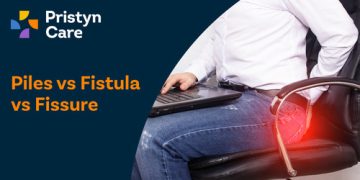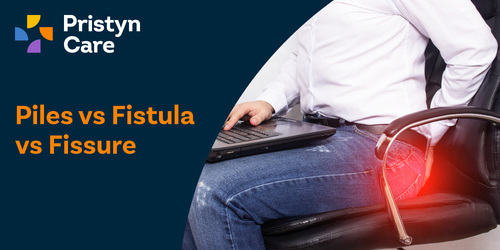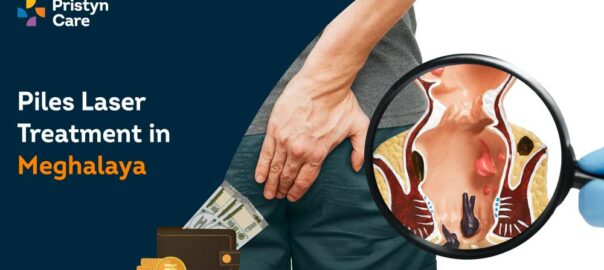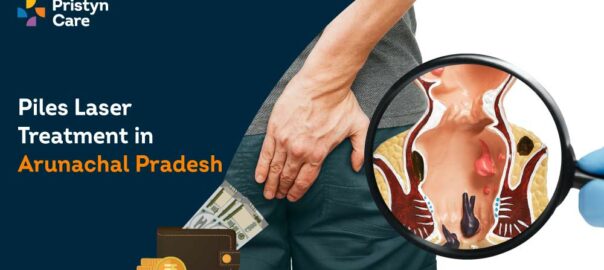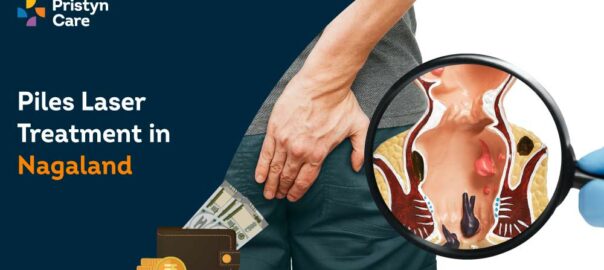![]() Views: 85
Views: 85
Piles vs Fistula vs Fissure
Dedicated Support at Every Step!
Our Doctors are available 24 hours a day, 7 days a week to help you!
This blog simplifies these medical terms and explains their key differences and treatments. Know what each condition entails and when to seek professional advice to make informed health decisions.
Table of Contents
Piles vs Fistula vs Fissure Differences | Overview
Piles, fistulas, and fissures are common conditions that affect the anal area. Each has distinct characteristics and treatment approaches. This overview will help you understand the key differences between them.
- Piles (Haemorrhoids) are swollen blood vessels in or around the anus and lower rectum. They can be internal or external. External piles appear around the anus. They often cause discomfort and bleeding during bowel movements. Internal piles are deeper inside the rectum. You might not see these, but they can bleed and become painful if they prolapse (fall out).
- Fistulas, known as anal fistulas, are abnormal tunnels between the skin near the anus and the inside of the anal canal. They are often the result of an infection or an abscess that hasn’t fully healed. Fistulas can be painful and may discharge pus or blood. They rarely heal by themselves and usually require surgery to prevent further infection.
- Fissures are small tears in the mucosa of the anus. These occur when passing large or hard stools. A fissure can cause severe pain and bleeding with bowel movements. It feels like a sharp cut and can be very uncomfortable, especially during and just after a bowel movement.
No Cost EMI, Hassle-free Insurance Approval
Symptoms of Piles, Fissures, and Fistulas
Each of these conditions affecting the anal area displays distinct symptoms. Recognising these symptoms of piles, fissures, and fistulas can help in seeking timely medical advice.
Piles (Haemorrhoids):
- Bleeding: Bright red blood appears on toilet paper or in the toilet after a bowel movement.
- Swelling: A lump near the anus, which may be sensitive or painful.
- Itching: Persistent itching around the anal area.
- Pain: Discomfort or pain during or after bowel movements.
- Mucous discharge: A slimy discharge from the anus.
- Feeling of fullness: The sensation of having an incomplete bowel movement.
- Protrusion during bowel movements: Tissue bulges out of the anus during bowel movements but retracts on its own.
- Soreness: The area around the anus is tender and uncomfortable.
Fistulas:
- Painful bowel movements: Pain is more severe during and after passing stools.
- Skin irritation: Persistent irritation around the anus.
- Discharge: Pus or blood discharge from an opening near the anus.
- Swelling: Noticeable swelling or a hard area around the anus.
- Fever: Occasional fever as a sign of infection.
- Foul smell: Unpleasant odour due to the discharge.
- Repeated abscesses: Recurrent boils or abscesses near the anus.
- Difficulty sitting: Discomfort or pain when sitting down, especially on hard surfaces.
Fissures:
- Severe pain during bowel movements: A sharp pain when stools pass.
- Visible tear or cut: A small visible crack in the skin around the anus.
- Bleeding: Bright red blood noticeable on tissue or stools.
- Burning sensation: An intense burning pain following bowel movements.
- Itching: Anal itching or irritation.
- Prolonged pain: Pain that lasts for several hours after defecation.
- Skin tag: A small tag of skin that may develop near the fissure.
- Tight anal sphincter: The muscles around the anus may be unusually tight.
Causes of Piles, Fissures, and Fistulas
Here are the causes of piles, fissures, and fistulas that can help prevent these uncomfortable conditions and guide appropriate treatments.
Piles (Haemorrhoids):
- Chronic Constipation: Straining during bowel movements can cause the veins in the rectal area to swell.
- Pregnancy: Increased pressure in the abdomen during pregnancy often leads to piles.
- Ageing: As you age, the tissues supporting the veins in your rectum and anus can weaken and stretch.
- Heavy Lifting: Regularly lifting heavy objects can increase abdominal pressure, leading to piles.
- Long Periods of Sitting: Sitting for extended periods without moving can cause piles.
- Obesity: Excess body weight increases pressure on the abdominal and pelvic veins.
- Diet: A low-fibre diet can lead to constipation, exacerbating piles.
- Diarrhoea: Frequent diarrhoea can also irritate the tissues around the anus.
- Genetics: A family history of piles can increase your risk.
Fistulas:
- Anal Abscesses: An untreated abscess near the anus can lead to a fistula.
- Crohn's Disease: This inflammatory bowel disease is a common cause of fistulas.
- Surgery: Certain surgeries near the anus may inadvertently lead to fistulas.
- Infection: Bacterial infections can erode the tissue and form a tunnel.
- Trauma: Injury to the anal area can sometimes result in a fistula.
- Radiation Therapy: Treatment for cancer near the pelvic area can cause fistulas.
- Diverticulitis: This condition involves inflammation of an abnormal pouch in the intestinal wall and can lead to fistulas.
- Tuberculosis: In rare cases, tuberculosis in the pelvic area can cause fistulas.
- HIV/AIDS: Immune system deficiencies increase the risk of infections that can lead to fistulas.
Fissures:
- Passing Large Stools: Large or hard stools can tear the lining of the anus.
- Chronic Diarrhoea: Frequent bowel movements can irritate and tear the anal lining.
- Childbirth: Women are at higher risk during and after childbirth due to pressure and tearing.
- Poor Hygiene: Insufficient cleaning of the anal area can irritate and tear the skin.
- Overuse of Laxatives: Excessive use can lead to diarrhoea and subsequent fissures.
- Anal Intercourse: This can cause physical trauma to the anal canal.
- Underlying Diseases: Conditions like Crohn’s disease can make you more prone to fissures.
- Decreased Blood Flow: Reduced blood flow to the anal area can make the skin more susceptible to tearing.
- Excessive Wiping: Rough or excessive cleaning of the anal area can cause skin irritation and fissures.
Understanding these causes provides critical insights into preventive measures and treatment strategies. If you experience symptoms associated with any of these conditions, consult a healthcare professional for appropriate advice.
Best Treatment for Piles, Fissure, and Fistula
Managing conditions like piles, fissures, and fistulas effectively involves a combination of medical treatments and lifestyle adjustments. Take a look at the most effective treatment options for each of these conditions.
Piles (Haemorrhoids):
- Medicinal Creams and Ointments: Products containing hydrocortisone or witch hazel can reduce inflammation and soothe pain in the affected area.
- Soothing Sitz Baths: Regular warm sitz baths help alleviate pain and reduce swelling. Aim for 15-minute sessions several times a day, especially after bowel movements.
- Dietary Modifications: Incorporating a high-fibre diet helps soften stools, which reduces the need to strain during bowel movements. This can prevent the worsening of existing piles.
- Adequate Fluid Intake: Drinking at least eight glasses of water daily helps maintain hydration and supports healthy bowel movements.
- Cold Compresses: Applying ice packs to the affected area can decrease swelling and numb the discomfort temporarily.
- Stool Softeners: These are useful in making stool easier to pass, which prevents the haemorrhoids from becoming aggravated.
- Non-intrusive Procedures: Techniques like rubber band ligation or sclerotherapy effectively reduce the size of haemorrhoids by cutting off their blood supply.
- Surgical Options: In severe cases, surgical interventions such as haemorrhoidectomy or stapled haemorrhoidopexy may be recommended to remove or reposition the haemorrhoids.
- Preventive Measures: Regular exercise, maintaining a healthy weight, and avoiding long periods of sitting can prevent the formation or worsening of haemorrhoids.
Fissures:
- Topical Pain Relievers: Applying anaesthetic creams can temporarily relieve pain by numbing the anal area.
- Topical Nitroglycerin: This treatment helps to relax the anal sphincter and improve blood flow to the area, aiding in healing.
- Surgical Intervention: For chronic fissures, a lateral internal sphincterotomy might be performed to decrease sphincter spasms and promote healing.
- Botulinum Toxin Injections: Botox injections can relax the sphincter muscles, which reduces pain and facilitates the healing process.
- Fibre Supplements: These help bulk up stool and prevent hard stools that can cause new fissures or exacerbate existing ones.
- Therapeutic Baths: Regular sitz baths can promote healing by increasing blood flow and keeping the area clean.
- Analgesics: Over-the-counter pain relievers can help manage the discomfort associated with anal fissures.
- Careful Cleaning: Ensuring the anal area is gently cleaned and dried after bowel movements can prevent further irritation.
- Lifestyle Adjustments: Avoiding activities that exacerbate the fissure, such as heavy lifting, can be beneficial.
Fistulas:
- Surgical Drainage: Opening up the fistula tract (fistulotomy) is a common and effective treatment to promote healing from the inside out.
- Seton Techniques: A seton (a loop of surgical thread) is used to gradually cut through the fistula, which helps it heal over time.
- Advancement Flaps: A procedure where healthy tissue is moved over the internal fistula opening to close it and promote healing.
- Bioprosthetic Plug Insertion: Plugging the fistula tract with a biodegradable material to encourage natural healing.
- Fibrin Sealant: A special glue injected into the fistula to seal it and help it heal without the need for more invasive surgery.
- LIFT Technique: A newer procedure that involves ligating the fistula tract close to the internal opening and removing the infected tissue.
- Antibiotic Therapy: Used to treat any underlying infection that might be contributing to the fistula’s persistence.
- Immunomodulatory Drugs: Particularly useful for fistulas related to Crohn’s disease, these drugs help modulate the body’s immune response.
- Regular Hygiene: Keeping the anal area clean and dry is crucial for preventing infections and aiding in the healing process.
Here is a concise table summarising the symptoms, causes, and the best treatment for piles, fissures, and fistulas:
| Condition | Symptoms | Causes | Treatments |
| Piles (Haemorrhoids) | - Bleeding: Bright red blood during bowel movements. - Swelling: Painful lumps near the anus. - Itching: Persistent irritation. - Pain: During and after bowel movements. - Mucous Discharge: Slimy secretion. - Feeling of Fullness: Incomplete bowel evacuation. - Protrusion: Tissue bulges out but retracts. - Soreness: Tenderness around the anus. | - Chronic Constipation: Frequent straining. - Pregnancy: Increased abdominal pressure. - Ageing: Weakening of rectal tissues. - Heavy Lifting: Increases abdominal pressure. - Prolonged Sitting: Decreased blood flow. - Obesity: Higher pressure on pelvic veins. - Poor Diet: Low fibre intake. - Diarrhoea: Irritates rectal tissues. - Genetics: Family history. | - Medicinal Creams: Hydrocortisone, witch hazel. - Sitz Baths: Regular warm baths. - Dietary Changes: High-fibre foods. - Hydration: Plenty of fluids. - Cold Compresses: Reduce swelling. - Stool Softeners: Easier bowel movements. - Procedures: Rubber band ligation, sclerotherapy. - Surgery: Haemorrhoidectomy for severe cases. - Exercise: Regular physical activity. |
| Fistulas | - Painful Movements: Severe pain during stools. - Skin Irritation: Continuous discomfort. - Discharge: Pus or blood. - Swelling: Noticeable and painful. - Fever: Signs of infection. - Foul Smell: Due to discharge. - Repeated Abscesses: Frequent infections. - Sitting Difficulty: Pain on hard surfaces. | - Anal Abscesses: Incomplete healing. - Crohn's Disease: Chronic inflammation. - Surgical Complications: Post-operative issues. - Infections: Bacterial, leading to tissue erosion. - Physical Trauma: Direct injury. - Radiation: Cancer treatment side effects. - Diverticulitis: Inflammation of intestinal pouches. - Tuberculosis: Rare, but possible cause. - HIV/AIDS: Compromised immune system. | - Fistulotomy: Opens and flattens tract. - Seton Placement: Gradual healing. - Advancement Flaps: Covers the internal opening. - Bioprosthetic Plugs: Fills and heals the tract. - Fibrin Glue: Seals the fistula. - LIFT Procedure: Internal ligation of the tract. - Antibiotics: For underlying infections. - Immunomodulators: For Crohn's associated cases. - Hygiene Practices: Regular cleaning and drying. |
| Fissures | - Severe Pain: Sharp pain during bowel movements. - Visible Tear: Crack in the skin. - Bleeding: Bright red blood on tissue. - Burning Sensation: After bowel movements. - Itching: Around the anus. - Prolonged Pain: Lasts hours post-defecation. - Skin Tag: Near the fissure. - Tight Sphincter: Increased muscle tension. | - Large Stools: Causes tears. - Chronic Diarrhoea: Frequent irritation. - Childbirth: Pressure and tearing. - Poor Hygiene: Leads to irritation and tears. - Laxative Overuse: Diarrhoea and tears. - Anal Intercourse: Can cause trauma. - Underlying Diseases: E.g., Crohn’s disease. - Reduced Blood Flow: Less healing capacity. - Excessive Wiping: Further irritates the area. | - Pain Relievers: Anaesthetic creams. - Topical Nitroglycerin: Improves blood flow. - Sphincterotomy: Reduces tension. - Botulinum Toxin: Eases muscle spasms. - Fibre Supplements: Softens stools. - Sitz Baths: Promotes blood flow. - Analgesics: Manage pain. - Careful Cleaning: Gentle hygiene practices. - Activity Modification: Avoid exacerbating factors. |
Ending Notes
The Piles vs Fistula vs Fissure differences are significant, each requiring specific approaches for effective management. Recognising the symptoms early and understanding the underlying causes is crucial to selecting the right treatment. Whether it's adopting lifestyle changes, trying over-the-counter aids, or considering surgical options, the right knowledge empowers you to make informed decisions.
Always consult healthcare professionals to get tailored advice and treatment plans. All in all, each condition can significantly impact your quality of life, but with proper management, you can achieve relief and return to your daily activities with comfort and confidence.



